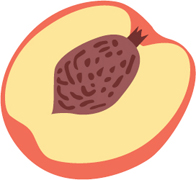
PEACHES
When peaches first arrived in Europe, no one had any idea that they had come all the way from China. The Romans thought they came from Persia and called them ‘Persian apple’ (Malum persicum ), which became then pêche in French and eventually ‘peach’ and a handy way to describe a colour, a flavour, a complexion (with cream), a desirable person and utter perfection.
Peaches certainly set the juicy–sweet sublime bar high. If you have a tree in your garden, you can choose the perfect moment to pick a peach to enjoy fresh, serve on a platter or toss into a salad. The rest of us have to rely on trays of overripe and underripe fruit with signs declaring ‘Do not squeeze me’. Peaches are good cookers, and although the flavour and texture are not the same as fresh, they are equally delicious poached, halved, stuffed and grilled, or baked for desserts. They make wonderful jams and conserves, chutneys and relishes, salsas and sauces.
WHAT TO LOOK FOR
Peaches are picked when they are ripe but still firm. They will soften after being picked but will not ripen further (or get sweeter). Choose medium to large plump fruit with unwrinkled skins. When determining ripeness, pay attention to colour, not the red ‘blush’ on their cheeks, which depends on the variety. You want to look for the background colour of yellow to cream, particularly around the stem. If there is a bit of green, it means the fruit is not yet ripe. Gently press or squeeze the shoulder and tip (where the stem was) – if it just starts to give, it’s ripe and ready to eat. If you can, buy freestone peaches (and nectarines), they are so much easier to use in your cooking than clingstone.
Tinned peaches are popular. Look for brands in water or natural juice with no added sugar.
HOW TO STORE THEM
Store firm peaches and nectarines stem side down in the fruit bowl at room temperature, out of sunlight, for a few days until they soften. Eat them or use them right away because they are highly perishable. They will keep for 2–3 days in the refrigerator but they should never be refrigerated until they are fully ripe. Chilling them before that will result in fruit that is mealy and flavourless.
WHAT’S IN THEM?
One small peach (about 145 g/5¼ oz) has about 210 kilojoules (50 calories), 1.5 g protein, no fat, 9 g carbs (all sugars), 2 g fibre, 270 mg, potassium a low GI (42) and GL (4).
WHAT ELSE?
To remove the stone from nectarines, apricots, peaches and plums, use a small serrated knife to cut along the seam from top to bottom, twist and hopefully the stone will pop out. If it doesn’t, cut small wedges of flesh through to the stone and then continue cutting around the stone until it comes away.
HERO RECIPE
Baked peaches bombe Alaska (here )